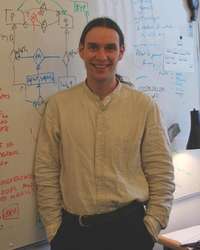
Title: Control Theoretical Models of Pointing
Speaker: Rod Murray-Smith, University of Glasgow
http://www.dcs.gla.ac.uk/~rod/
Abstract: I will talk about two topics:
1. (Joint work with Jörg Müller & Antti Oulasvirta) I will present an empirical comparison of four models from manual control theory on their ability to model targetting behaviour by human users using a mouse: McRuer’s Crossover, Costello’s Surge, second-order lag (2OL), and the Bang-bang model. Such dynamic models are generative, estimating not only movement time, but also pointer position, velocity, and acceleration on a moment-to-moment basis. We describe an experimental framework for acquiring pointing actions and automatically fitting the parameters of mathematical models to the empirical data. We present the use of time-series, phase space and Hooke plot visualisations of the experimental data, to gain insight into human pointing dynamics. We find that the identified control models can generate a range of dynamic behaviours that captures aspects of human pointing behaviour to varying degrees. Conditions with a low index of difficulty (ID) showed poorer fit because their unconstrained nature leads naturally to more dynamic variability. We report on characteristics of human surge behaviour in pointing. We describe trade-offs among the models. We conclude that control theory offers a promising complement to Fitts’ law based approaches in HCI, with models providing representations and predictions of human pointing dynamics which can improve our understanding of pointing and inform design.
2. Casual control. How and why we can design systems to work at a range of levels of engagement.
Biography: Roderick Murray-Smith is a Professor of Computing Science at Glasgow University, in the “Inference, Dynamics and Interaction” research group and the Head of the Information, Data and Analysis Section. He works in the overlap between machine learning, interaction design and control theory. In recent years his research has included multimodal sensor-based interaction with mobile devices, mobile spatial interaction, Brain-Computer interaction and nonparametric machine learning. Prior to this he held positions at the Hamilton Institute, NUIM, Technical University of Denmark, M.I.T., and Daimler-Benz Research, Berlin, and was the Director of SICSA, the Scottish Informatics and Computing Science Alliance. He works closely with the mobile phone industry, having worked together with Nokia, Samsung, FT/Orange, Microsoft and Bang & Olufsen. He was a member of Nokia’s Scientific Advisory Board and is a member of the Scientific Advisory Board for the Finnish Centre of Excellence in Computational Inference Research. He has co-authored three edited volumes, 22 journal papers, 16 book chapters, and 88 conference papers.











